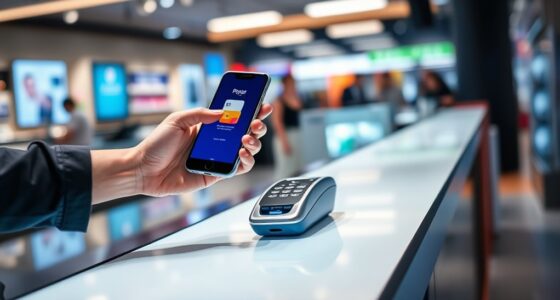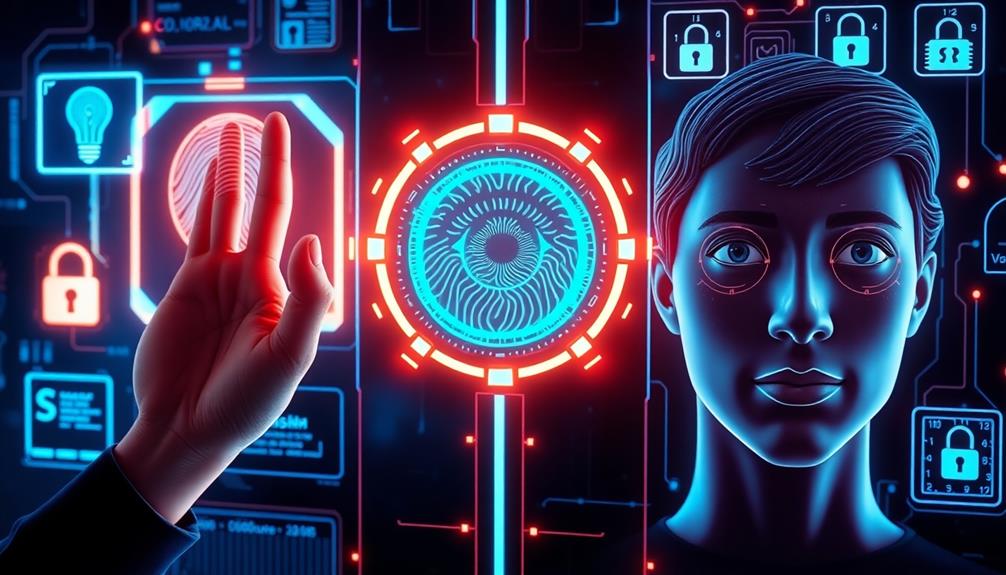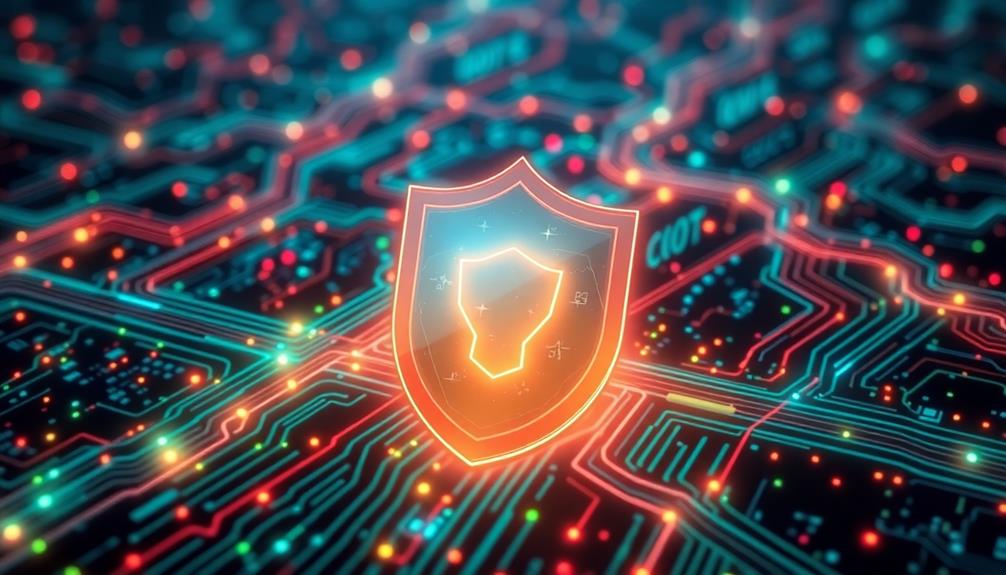Biometric authentication offers a faster, more secure way to verify your identity during payments compared to traditional passwords. It uses unique physical traits like fingerprints or facial recognition, making it harder for others to mimic or steal your info. Unlike passwords, biometrics don’t require memorization and are less vulnerable to hacking. While there are privacy concerns, their convenience and improved security are making them increasingly popular. Keep exploring to discover how these methods compare and improve your payment security.
Key Takeaways
- Biometrics offer stronger security by using unique physical traits, making them harder to spoof than traditional passwords.
- Passwords are vulnerable to hacking, phishing, and reuse, whereas biometric data is more difficult to compromise.
- Biometrics provide faster, more seamless authentication, enhancing user experience compared to remembering and entering passwords.
- Privacy concerns arise with biometric data storage, as breaches can reveal sensitive personal information that cannot be reset like passwords.
- Overall, biometrics improve fraud prevention and security but must be balanced with privacy and data protection considerations.

Payment authentication is a essential step in ensuring secure transactions online. When you make a purchase or transfer funds, verifying your identity helps protect both you and the merchant from fraud. Fraud prevention is the primary goal here, and choosing the right authentication method plays a key role. Traditionally, passwords have been the go-to solution, but with rising cyber threats, many are turning to biometrics for enhanced security. As a user, you want a system that not only confirms your identity reliably but also offers convenience without compromising safety.
Payment security relies on choosing the right authentication method to prevent fraud and protect users.
Passwords are familiar and straightforward, but they come with notable drawbacks. You might worry about remembering complex combinations or keeping track of multiple passwords across different sites. More importantly, passwords are vulnerable to hacking, phishing, or theft if not managed carefully. Cybercriminals often exploit weak or reused passwords to access sensitive information. That’s where user verification becomes a challenge—how do you ensure that the person entering a password is genuinely you? While multi-factor authentication adds an extra layer, it still relies on something you know, which can be compromised. As a result, fraud prevention with passwords sometimes falls short, especially when users choose simple passwords or fall victim to social engineering.
Biometrics, on the other hand, offer a different approach. By using unique physical traits such as fingerprints, facial recognition, or iris scans, biometric authentication verifies your identity in a way that’s difficult for others to replicate. This method substantially improves user verification because it’s inherently tied to your biological features. When you use biometrics, you don’t need to remember complex passwords or carry additional devices; your body becomes the key. Many modern smartphones and banking apps now incorporate biometric security, making transactions faster and more secure. Biometrics are also more resistant to common hacking techniques, lowering the risk of fraud.
However, biometric systems aren’t flawless. Concerns about privacy and data security arise because storing biometric data involves sensitive information. If a breach occurs, unlike a password, you can’t change your fingerprint or face. Despite this, many experts agree that biometric authentication improves fraud prevention because it’s much harder to spoof or steal your physical traits compared to hacking a password. As a user, you benefit from this enhanced security without sacrificing ease of use. Overall, while passwords remain prevalent, biometrics offer a promising alternative for more reliable and user-friendly payment authentication, making your transactions safer and more seamless.
Frequently Asked Questions
How Do Biometric Systems Handle False Rejections?
Biometric systems handle false rejections by adjusting biometric thresholds, making it easier for legitimate users to be recognized. When false rejection rates are high, you can lower these thresholds, but that might increase false acceptances. The system balances security and convenience by fine-tuning these settings based on your needs. If you experience frequent false rejections, contacting support to recalibrate the system can help improve accuracy without compromising security.
What Are the Privacy Concerns With Biometric Data?
You worry about your biometric data being misused, stolen, or accessed without your approval. Privacy concerns include data breaches, unauthorized sharing, and potential misuse of your unique identifiers. You want to make certain your information is protected through robust data encryption and that you give informed user consent before your biometric details are collected. By prioritizing these measures, you can feel more secure knowing your sensitive data stays private and under your control.
Can Passwords Be Made as Secure as Biometrics?
Yes, passwords can be made as secure as biometrics by using complex, unique combinations and multi-factor authentication. You should avoid common password vulnerabilities like simple words or reuse. Implementing biometric scalability, such as fingerprint or facial recognition as part of a layered security system, enhances protection. Regularly updating passwords and employing password managers also help strengthen security, making passwords a more reliable alternative to biometric data.
How Do Biometrics Perform in Low-Light Conditions?
In low-light conditions, biometric systems like facial recognition often rely on infrared sensors to perform accurately. These sensors detect heat signatures and facial features even in darkness, making authentication seamless. Without sufficient light, traditional cameras struggle, but infrared technology guarantees your face is still recognized swiftly. So, rest assured—biometric authentication remains reliable, even when lighting isn’t ideal, keeping your payments secure and hassle-free.
What Are the Costs Associated With Implementing Biometric Authentication?
Implementing biometric authentication involves costs like purchasing specialized hardware, software integration, and staff training. You should conduct a thorough cost analysis to evaluate these expenses against security benefits. Keep in mind, implementation challenges such as ensuring data privacy, managing false rejections, and maintaining system accuracy can add to the overall costs. While initial investments might be high, the enhanced security and user convenience often justify the expenditure.
Conclusion
Choosing between biometrics and passwords is like selecting the key to your personal safe. Biometrics offer a sleek, modern lock that’s hard to duplicate, while passwords are familiar but easier to pick or forget. As technology evolves, biometrics act like a fingerprint on your door—unique and secure—making your payment process smoother. Embrace the future of payment authentication, and let your security be as natural and effortless as a fingerprint on your skin.










